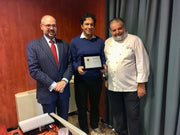Bees in a biodynamic farm

The mineral, vegetable, animal and human kingdoms each play a role in the economics of nature and the farm. The fundamental task of plants is to organise mineral matter, i.e. to transform mineral salts and elements into living matter through the fundamental process of chlorophyll photosynthesis. For their part, animals have the task of transporting and circulating this matter and they do it differently according to their characteristics.
We can consider animals concerning the biodynamic farm on three levels: animals that live in the subsoil whose main representative for the farmer is the earthworm. Then there are domestic animals that trample the soil among which the role of ruminants in the transformation of the plant substance and lastly, air-occupying animals such as insects and birds. The right balance between the types of insects and birds is crucial for the crops to thrive. Often insects are a problem that farmers need to tackle, but the high biodiversity of insectivorous birds is an excellent solution because each insect has its predator or antagonist that keeps it under control.
However, not all insects are harmful, there are many useful ones such as ladybugs, fireflies, osmias and above all bees. Rudolf Steiner, the founder of biodynamic agriculture, has reserved a series of very beautiful and interesting conferences* that deal with the role of bees both in the economy of nature and concerning human beings.
Bees are particularly important for agriculture and have been linked to humans since time immemorial. The exact time, when beekeeping was adopted, is unknown, but some testimonies take us back more than 10,000 years. Bees do not only provide honey, but their flights create a special protective net over the fields they travel to daily. Bees tend to collect nectar from the most productive plants of each period and they usually devote themselves to one species at a time. For example, when acacia is blooming, bees are always focussed on the acacia flowers until they have cleared every one of them.
Bees are particularly linked to the sun and the element of Silicon so much that their cells look like countless silicon crystals put together, in the flowers and nectar, we find the result of the sun's action and bees are greedy for it. When they fly, it is as if they carry many small rays of sunshine and this is what creates an invisible network above the farm that stimulates the growth of plants. There are species such as vines that do not need bees for pollination, but the mere presence of bees in the vineyard can positively stimulate plant health. There doesn't need to be hives on the farm, blooms are enough to climb in the green manures, hedges or permanent grassing between the rows of the vineyards and the bees get lured by this and will gladly forage, that is to collect the flowers' nectar. Ecological corridors for bees are fundamental in this context, consisting of honey essences placed in sequence, to create "special roads" that allow the bees to always find flowers where they can collect nectar.
In biodynamic agriculture, a specific silicon-based biodynamic preparation is also used to increase the plant's ability to assimilate sunlight. The use of this preparation, which is called cornosilica, also helps the bees' life because it makes the farm more suitable for them. Bees in a biodynamic farm bring health and receive it in a reciprocal exchange at the same time.
The biodynamic farmer supports the natural processes so that they take place correctly, favouring the life of the soil, the health of the plants and the activity of animals including the precious bees.
*O.O. 351 "Bees" Rudolf Steiner / CW 351 "Bees"
by Elena Zaramella







